Resistance bands are incredibly useful tools for boosting power, muscle, and strength, all from the comfort of your own home. You can easily target every muscle group in your body and adjust your workouts to improve performance.
Resistance bands are available in a variety of thicknesses and resistance levels.
Rankings
1. GRM Resistance Bands
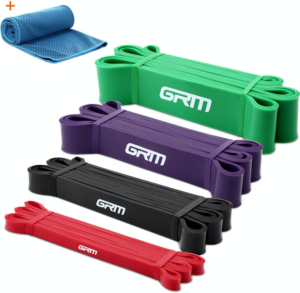
Click here for the lowest price
GRM resistance bands come in a set of four that range in resistance between 15 lbs and 125 lbs. They also boast an impressive 82-inch circumference making them suitable for all fitness enthusiasts.
Whether you’re serious about fitness, or rehabilitating a muscle or joint injury, GRM resistance bands are effective for a range of exercise types including yoga, weightlifting, and stretching.
2. Recredo Booty Bands

Click here for the lowest price
Constructed of a white fabric material rather than natural latex, the Recredo Booty Bands are a comfortable, high-quality product that can be used for all types of exercise, including CrossFit, P90X, and weightlifting.
With three levels of resistance, you can adapt your routine based on your current strength level to get the best out of your training.
3. Epitomie Fitness Bionic Flex Pull Up Assistance Band

Click here for the lowest price
Epitomie fitness bands come with four different bands of varying resistance (between 50-120lbs), allowing you to better target the strength level of each area of your body.
Epitomie fitness bands have a unique polymer coating. This provides added durability, and dual-layer construction to prevent snaps and breaks while exercising.
4. Amonax Mini Resistance Loop Bands Set
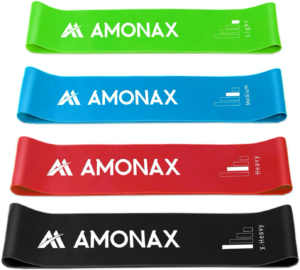
Click here for the lowest price
The Amonax Mini Resistance Loop Bands Set is the best option if you are inexperienced with resistance band exercises. Each band has exercises printed directly on it to guide you through your workout.
These bands offer slightly less resistance than the other sets on this list, ranging from 10 to 50 lbs of resistance. Each Amonax Mini Resistance Loop Band is made with high-quality latex. Despite the lower levels of resistance, Amonax bands are best for those looking to aid in the rehabilitation of an injury.
5. ProFitness Hip Resistance Bands
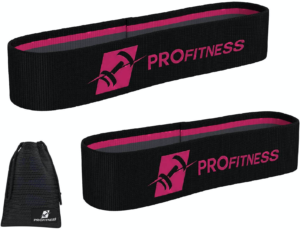
Click here for the lowest price
ProFitness hip resistance bands come with two different sized loops and the choice between small/medium and large/extra-large when ordering your product. They help to improve your flexibility, rehabilitate injured joints, and build muscle and strength.
To make these bands safer than competing products, ProFitness hip resistance bands include anti-slip stripes that hold the bands in place throughout your exercises. ProFitness also offers a lifetime warranty on their products.
6. Letsfit Resistance Bands Set
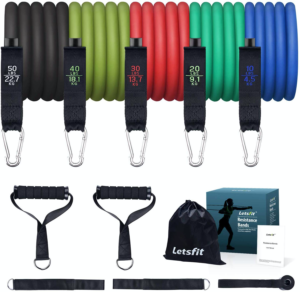
Click here for the lowest price
The Letsfit resistance band set comes with five colored bands that have a range of resistance between 5 and 35 lbs. Although the strongest band in the set has a resistance of 35 lbs, you can combine several bands to yield resistance of 100 lbs. The best aspect of these bands is their high durability.
This set comes with cushioned handles for added comfort and better performance during exercises. If you’re new to using resistance bands, the Letsfit resistance band set comes with a guide describing exercises you can perform.
7. Walito Resistance Bands
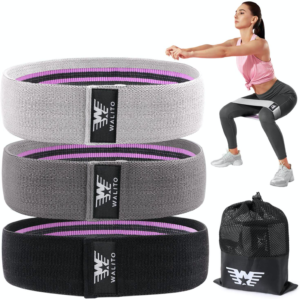
Click here for the lowest price
Walito resistance bands are another selection that is sold for legs and glutes but is also effective on any other part of the body. These bands can provide extra resistance during many of the exercises seen in yoga, P90X, Insanity, and CrossFit.
With this set, you’ll get three hip bands that include light, medium, and heavy resistance. Each band is constructed of a polyester, cotton, and latex combination that provides adequate durability and versatility for any exercise.
8. TheFitLife Exercise Resistance Bands with Handles

Click here for the lowest price
The TheFitLife exercise bands with handles have the greatest range of resistance provided. The set comes with five different colored bands that have a range of 10 lbs to 110 lbs.
TheFitLife resistance bands are constructed with an anti-snap all-natural latex material. These bands also come with detachable handles, ankle straps, and a door anchor. The attachments in this set allow the bands to be used for a diverse range of exercises.
9. Etoplus Resistance Bands
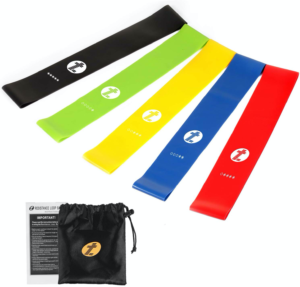
Click here for the lowest price
The Etoplus resistance bands are loop bands that come in a set of 5. With resistance levels ranging from 5 to 40 lbs, these bands would be most beneficial to older populations, exercise beginners, or those rehabilitating an injury.
Etoplus resistance bands are high-quality products made from 100% non-toxic and odor-free latex. Etoplus resistance bands also come with a carrying bag to help you store the product when it’s not in use or transport your bands to the gym.
10. HPYGN Resistance Bands Set
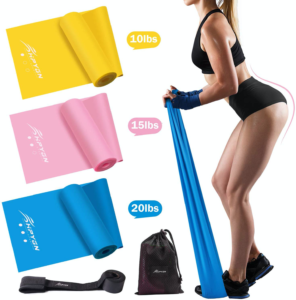
Click here for the lowest price
The HPYGN resistance bands set comes with bands from 10 to 20 lbs of resistance and are an impressive 5 feet long and 6 inches wide. Engineered with a built-in door anchor, these resistance bands allow you to perform a wide variety of exercises during your routine.
They are also 100% scent-free and latex-free, making it suitable for those with latex allergies.
How We Ranked
Resistance bands come in 4 main categories: therapy bands, loop bands, figure 8 bands, and tube bands. We decided to include all four types on our list because they all offer different benefits to consumers. Therapy bands, like HPYGN, are used for rehabilitation, making them great for injuries and older adults. HPYGN bands also included a door anchor, which gave users flexibility in what exercises they can perform. Figure 8 bands, while great for strength training, were not included on our list due to their lack of versatility.
Loop bands directly target lower body muscles like the glutes and hamstrings, making them ideal for gym-goers and women looking to build a muscular lower body. Walito loop bands ranked well for a fabric combination of cotton, latex, and polyester to improve durability. Tube bands are one of the most popular forms of resistance bands and are great for providing full-body exercises. The Letsfit resistance band set ranked highly for providing cushioned handles that allowed for better exercise performance and comfort.
Latex can cause allergic reactions in certain individuals, so we strived to include several brands that were made with non-latex materials like the Recredo resistance bands, to avoid any possible allergic reactions. Our top pick, GRM resistance bands, came in a large 82-inch circumference providing a large band for a variety of exercises and uses. It’s four resistance levels, and high-quality design makes it ideal for every type of fitness level and exercise.
Benefits
Resistance bands can help to rehabilitate previous injuries or health conditions. A 2018 study concluded that there was no major difference between using resistance bands or doing other exercises for injury rehabilitation. This demonstrates that resistance band training is comparable to other exercises in terms of rehabilitating injuries (1).
Another study published in 2015 found that resistance bands can improve lower body strength in those with diabetes. In a condition where it’s not unusual to experience reduced blood flow to the lower body, these results are significant (2).
In a unique study from 2017, researchers focused on individuals with dementia, specifically those with depression or other behavioral issues. Over 15 months, participants engaged in training sessions three times per week. The researchers discovered that participants in the program experienced reduced levels of depression and other behavioral issues (3).
Resistance bands are comparable to some free weight exercises. In a study published in 2019, researchers focused on the effects of strength improvements between conventional training techniques and resistance band exercises. The study determined there was no significant difference in strength improvements between the two methods (4).
In 2017, one study placed more of an emphasis on multi-joint exercises that could be performed with resistance bands. When compared to conventional resistance training techniques, resistance bands provided similar benefits for stiff-legged deadlifts, lateral pulldowns, and unilateral rows (5).
Resistance bands can improve sport-specific performance. Resistance bands have been shown to improve sport-specific performance.
In a 2020 study, researchers analyzed the effects that specific resistance band exercises had on female softball players. After participation in an 8-week study focused on resistance bands, scientists were able to conclude that resistance bands could be a viable alternative to regular resistance training methods for improving range of motion and velocity of overhand throws (6).
Resistance bands can help improve flexibility and balance. Resistance bands are effective in boosting flexibility and balance.
Most studies that have focused on improvements in balance and flexibility after using resistance bands have focused on older populations. For example, a 2017 study found that resistance bands improve flexibility in older individuals (7).
A 2016 study came to similar conclusions. Resistance band training routines implemented in older populations in rural areas improved their balance and flexibility, as well as their ability to walk (8).
Resistance bands take up very little space. Resistance bands are more space-friendly than other exercise equipment such as dumbbells, medicine balls, kettlebells, and barbells. Without taking up nearly as much space, resistance bands can provide similar effects to these pieces of equipment. Resistance band sets often come with carrying bags which also help with storage and portability.
Resistance bands can provide greater muscle stimulus. In certain exercises like bicep curls, the muscle isn’t always under tension. Resistance bands allow for complete resistance during the entire movement. As Dr. Jim Stoppani puts it: “The muscle is receiving greater resistance at its strongest point in the range of motion and therefore is receiving more adequate resistance to better stimulate strength adaptations.” (9).
Resistance bands can activate the core and prevent exercise cheating. Because resistance bands offer constant tension during exercise, your core needs to be consistently stabilized, leading to greater activation. This allows for a more smooth movement, preventing exercise cheating with momentum.
Resistance bands are inexpensive and convenient. Resistance bands are extremely lightweight and portable, making them the perfect travel companion for people who want to workout on the go. They are also great for fitness competitors that need a quick pump before a show. Resistance bands are also relatively inexpensive, with the thicker bands costing more.
Resistance bands can add assistance to certain exercises. Resistance bands can help make difficult exercises easier. Pull-ups, for example, are a bodyweight exercise thats can be very difficult to perform properly for most people. By placing a resistance band under your feet when performing them, you can make the exercise easier to perform, while still proving adequate resistance. This allows you to progress on exceptionally difficult bodyweight exercises.
Resistance bands can protect your bones and joints. Resistance bands can help to improve bone density and strength, by providing similar and sometimes even greater muscle activity as weight training. However, it does this while also lowering the amount of tensions placed on the joints, better protection them. Research shows that resistance training, whether in the form of free weights, bodyweight or resistance bands, helps build more cells in bones to prevent age related osteoporosis (10).
Side Effects
Resistance bands may cause injury. A study released in 2019 compiled data related to specific injuries caused by using resistance bands. Of the most common injuries reported, three were related to ocular trauma as a result of resistance band recoil.
The cases highlighted in the study determined that the recoiling resistance band caused lens dislocation in the three injured patients. This type of injury is serious and could require surgical intervention to minimize long-term negative effects.
The greatest risk of resistance bands recoiling comes with improper use, specifically failing to secure the band beneath your feet or another stabilizing object. When the resistance band slips, it will return to its point of origin at a speed directly correlated to the amount of force you were exerting upon it.
Most injuries related to recoiling resistance bands aren’t serious, but there are extreme cases that may cause serious injuries (11).
Resistance bands can cause an allergic reaction in those with latex allergies. In a study conducted in 2008, researchers analyzed the physical composition of some common resistance bands to determine if their makeup can cause allergic reactions in people with latex allergies.
Based on the results of their analysis, it was determined that most resistance bands include allergens that are capable of causing an intense allergic reaction at skin level. It’s recommended that those with latex allergies avoid using latex-based resistance bands in their exercise routines (12).
Recommended Usage
Anybody looking to improve their overall level of fitness can implement resistance bands into their exercise routine. Most resistance bands come in a variety of colors, with each color denoting a specific level of resistance. By purchasing a set of resistance bands with varying resistance levels, you can more effectively target each muscle group in your body.
When adding resistance bands into your exercise routine, use the bands similarly to free weight exercises. That means applying a similar set, repetition, and resistance strategy. Include rest days in your routine to allow your muscles to recover post-workout. If you are using them for recovery or rehab, make sure you aren’t straining your muscles and following proper form, to avoid further aggravating your injury.
FAQ
How do you use resistance bands? Resistance bands can be used to perform almost every exercise that you can perform with free weights. This includes multi-joint and single-joint exercises that target all muscle groups. To effectively use resistance bands, it’s important to emphasize safety by securing the band throughout your exercises. That means maintaining constant control over all areas of the band. Securing the band properly can make the difference between an effective workout and injury. To prevent injury from occurring, securely hold onto each handle and wear shoes to better grip the resistance band beneath your feet.
Can you build muscle with resistance bands? Whether you build significant amounts of muscle as a result of using resistance bands depends on how you’re using them and what your current diet consists of.
For building strength, work in low rep ranges of 5 to 8 reps. To build size work with high reps of 8 to 12 reps. If you’re working hard in the right rep range for your goal, you will be able to build muscle assuming you are consuming adequate protein and getting enough rest to allow your muscles to grow.
Do resistance bands burn fat? Resistance bands, like any other exercise method, can help you to burn fat if you use them properly. In this instance, what will make the greatest difference is the number of repetitions you perform.
The best way to burn fat is through endurance exercise. In terms of resistance band exercises, this means using lower resistance and performing a greater number of repetitions in the 15+ rep range.
How long do resistance bands last? High-quality bands should last several years without becoming damaged and breaking. If it’s a resistance band that’s not attached to any type of handle, it’ll last much longer.
What do resistance band colors mean? The colors of resistance bands describe the amount of resistance that each band provides. Some general guidelines can apply to most products on the market. The list below describes the colors of resistance bands from the least resistance to the most resistance: yellow, red, green, blue, black.
If you purchase resistance bands that have different colors than those listed above, your product will come with a color guide to describe the resistance of each band.
How effective are resistance band workouts? The effectiveness of resistance band workouts depends on what your goals are and how you use the equipment. To get the best out of your resistance band work out, select resistance, number of sets, and repetition targets that align with your current goals. It doesn’t make much sense to perform 20 repetitions at a low resistance when you’re trying to build power.
Other aspects of your lifestyle will also influence how effective your workouts are. It’s important to have a diet that promotes the goals you’re targeting. Basically: consuming fewer calories if you’re looking to lose weight, consuming more protein if you’re looking to gain muscle, etc.
Can you work out with resistance bands every day? As long as you’re using your resistance bands correctly, you can use them every day. What’s most important is making sure that you’re performing a split routine, and not overworking any single muscle or movement.
Can you burn calories when you use resistance bands? No matter what method of exercise you’re using, you’ll be burning calories. Some exercises burn more calories than others.
Resistance bands are similar to free weights for the number of calories you burn. That means they’re not the most efficient method of burning calories, but they are useful when it comes to building strength and power. To fully maximize the number of calories burned, you should also implement aerobic exercise into your routine.
Are free weights better than resistance bands? Free weights may be a better option if you’re focused on making progress that is displayed through data. When you use free weights, you can record the weight you’re using, as well as sets and repetitions. This is more difficult with resistance bands, as you can easily adjust your stance to adjust the resistance and it’s almost impossible to quantify the resistance you’re using.
If your goal is to improve strength and power while also building muscle, you can feasibly choose between resistance bands or free weights and expect the same or similar results.
How many types of resistance bands are there? There are 4 main types of resistance bands: therapy bands, loop bands, figure 8 bands and tube bands. Therapy bands are used for rehabilitation since they are gentle on the body. Loop bands are lower body specific resistance bands that help train and strengthen the lower body. Figure 8 bands are ideal for sports conditioning and strength training due to their easy grip. Tube bands are the most popular form and are used to train both the upper and lower body. They are usually round 4 feet long with two plastic handles on each end.
What do resistance bands do? Resistance bands help activate muscles to build strength, muscle, and flexibilty. They also help with physical therapy as they place less stress on joints. Resistance bands are a great substitute for normal gym equipment such as dumbells, machines, free weight, and kettlebells.
Are resistance bands good for older populations? Yes, research suggests that regular resistance bands training in older adults can improve balance, mobility and falls (13).
Do resistance bands tone muscles? Unfortunately, no exercise will help tone your muscles. However, resistance bands can improve strength and fat loss, helping to create that toned appearance. It does this by providing continuous and increasing tension during an entire exercise movement – unlike dumbells that sometimes only provide tension at certain points of the exercise.
Should people trying to gain muscle use resistance bands? People looking to gain muscle can certainly incorporate resistance bands into their routine to enhance their results. Resistance bands provide a new and challenging stimulus for muscle growth. You can also add them to your normal exercises, like deadlifts, to increase continuous resistance and provide a greater challenge.
Do resistance bands help make exercises easier? One of the most underlooked aspects of resistance bands is the ability to make difficult exercises easier. For example, adding a resistance band under your feet during a pull-up can help you perform more reps and get stronger.
Do resistance bands help with neck and back pain? Reisitnaace bands help to relieve neck and back pain through powerful stretching. Specifically, they help by elongating the muscles and releasing tension that can be built up by improper posture.
Are resistance bands travel-friendly? Yes, resistance bands are both lightweight and portable, making them the perfect companion for people who want to exercise during their travel and can’t find a gym. They take up almost no space in the luggage, making them perfect to fit in even your small carry-on bags.
Do resistance bands help with injury recovery and rehabilitation? Yes, resistance bands are exceptional at helping with rehabilitation and injury recovery because they provide adequate resiatcne,w without the joint strain. Furthermore, they don’t rely on gravity for resistance, allowing them to provide continuous tension during the entire range of movement.
Many exercises can also be done in a seated position, helping persons who are wheelchair-bound get a workout in.
Can resistance bands prevent bone breaks? Like most resistance training, resistance bands can help to improve bone strength and prevent osteoporosis.
Are resistance bands affordable? Yes, resistance bands are generally quite affordable, especially when compared to other exercise equipment.
Should people trying to lose weight use resistance bands? People looking to lose weight may use resistance bands to improve their efforts. Resistance bands can help to improve calorie expenditure and muscle retention during a calorie-reduced diet.
How do you choose the right resistance band? Choosing the right resistance bands depends on the type of workout you are doing and your fitness level. Thicker bands require more strength, while lighter bands are suitable for beginners and persons who want to add assistance to difficult bodyweight exercises such as pull-ups.
What is the best way to use resistance bands? One of the best ways to use resistance bands is to add them to any bodyweight movement for either a greater challenge or assistance.
Should athletes use resistance bands? Athletes can certainly use resistance bands to improve their power while preventing injuries.
Should pregnant women use resistance bands? Pregnant women can incorporate exercise bands to help improve their seep, energy, and mood during pregnancy.
Can resistance bands cause injury? In general, resistance bands prevent injury. However, in rare cases, they can cause workout injuries such as ocular trauma from resistance band recoil. Most injuries related to recoiling resistance bands aren’t serious, but there are extreme cases that may cause serious injuries.
Do resistance bands cause allergic reactions? If a resistance band is made of latex, it can cause allergic skin reactions in persons that are allergic to latex. People with latex allergies should avoid latex resistance bands. People who frequently use latex, such as doctors, should also avoid latex bands, as the continuous exposure of latex can cause a developed adverse reaction.
Do resistance bands help with old injuries? Yes, resistance bands can help rehab previous injuries. It’s been shown that resistance bands can provide similar effects in rehabilitation as free weights.
Can resistance bands help with depression? Yes, resistance bands may reduce depression. A 2017 study showed that people engaging in resistance band training for 40 minutes, three times per week, experienced reduced levels of depression (14).
Can resistance bands improve blood flow? Yes, resistance bands can improve total body blood flow, especially in patients with compromised blood flow like diabetics.
Are resistance bands comparable to the effects of free weights in terms of strength and muscle gains? Yes, resistance bands can provide similar effects as free weights in terms of strength and muscle gains. Specifically, studies show resistance bands can provide similar benefits to standard multi-joint exercises done with weights (15).
Are resistance bands effective at improving sport-performance in athletes? Yes, resistance bands have been shown to improve sport-specific performance. Specifically, they’ve been shown to improve the range of motion of overhand throw velocity in softball players. More research is needed to confirm the effects of resistance bands in other sports.
Can resistance bands improve balance? Yes, resistance bands can help improve balance by improving core activation, muscular strength, and flexibility. Specifically, studies show that resistance bands can improve flexibility in older populations (16, 17).
Are resistance bands bulky? No, resistance bands tend to take up very little space. Even the thickest bands are relatively thin, being able to fit in carry-on luggage. This makes resistance bands and portable workout tool for traveling as well as in condos with minimal workout space.
Do resistance bands provide muscle stimulus? Resistance bands can provide more muscle stimulus in ceratin exercise movements that don’t provide continuous resistance, like a bicep curl.
Do resistance bands help with exercise form? Yes, resistance bands help keep proper exercise form and prevent exercise cheating by providing continuous tension throughout the exercise. Furthermore, resistance bands activate and stabilize the core, preventing less swaying during heavy lifts – which can prevent injury.
Should older adults use resistance bands? Older adults can certainly use resistance bands to work out and keep flexible. Johns Hopkins Medicine recommends resistance bands as one of the safest methods to increase bone strength and help prevent osteoporosis.
Are resistance bands expensive? In general, resistance bands are not expensive, providing a relatively cheap option for an effective home workout. Extremely expensive resistance bands should be avoided because there is nothing making the actual band expensive – other than the marketing and branding.
Do resistance bands help make exercises easier? Resistance bands can help make certain difficult exercises easier by reducing tension. Specifically, resistance bands help make pull-ups easier by providing a little bit of push as you go up. This can help you make progress until you are able to complete exercises like this on your own. In general, bodyweight exercises are made easier by adding a resistance band. When resistance bands are added to exercises with weights, they can actually increase the difficulty – as in the case of multi-joint exercises like deadlifts.
Can resistance brands protect your joints? Yes, resistance bands tend to be safer for joints than free weights. This makes them ideal for persons with injuries as well as older people looking to protect their joints.
Can resistance bands protect your bones? Resistance bands can strengthen your bones, protecting the elderly from age-related osteoporosis. Resistance bands can help improve bone density by stimulating cellular repair and bone growth during exercise sessions.
Do resistance bands mimic regular weight training exercises? Yes, due to the variety and pliability of resistance bands, they can mimic most exercises done with free wights including bicep curls, tricep extensions, and lunges.
Do you need a spotter when you are using resistance bands? No, there is no need for a spotter when using resistance bands since the resistance isn’t based on gravity.
Recap
Resistance bands are one of the easiest methods when it comes to personalized at-home fitness routines. Without leaving your home, you can focus on every muscle group in your body to build muscle, strength, and power.
To get the most out of your resistance band routine, you’ll need to emphasize selecting the right exercises to target each muscle group and determining which level of resistance is ideal for your fitness goals. Just like any new exercise strategy, the most important thing you can do is emphasize proper form and resistance while working towards realistic goals.
For FitBug’s #1 resistance band recommendation, click here.